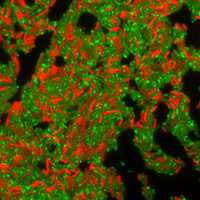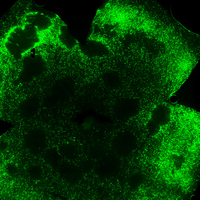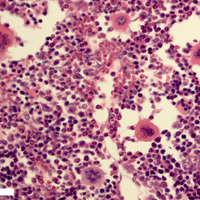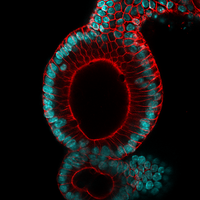Login
Subscribecell & molecular biology

Image of the Day: Training Day
Chia-Yi Hou | May 24, 2019 | 1 min read
A video captures T cells learning to recognize cells from the body that shouldn’t be attacked.

How Bacteria Become Drug-Resistant While Exposed to Antibiotics
Katarina Zimmer | May 23, 2019 | 4 min read
A membrane pump found in most bacteria helps E. coli acquire drug resistance from neighboring cells even while they’re exposed to antibiotics, a new study shows.

Found: A Cancer Drug’s Mechanism of Action
Ashley P. Taylor | May 21, 2019 | 4 min read
As ONC201 moves through human clinical trials, scientists finally figure out that the compound and its analogs target a mitochondrial protease.

Image of the Day: Internal Restructuring
Chia-Yi Hou | May 20, 2019 | 1 min read
Juvenile eels break down bone tissue and rebuild it in preparation for mating.

Neural Cell Types Tied to Autism Identified in Single-Cell Study
Ruth Williams | May 16, 2019 | 3 min read
An RNA analysis of human brain cells reveals gene expression changes in cortical neurons and microglia linked to autism spectrum disorder (ASD).

Image of the Day: Sticky Telomeres
Chia-Yi Hou | May 16, 2019 | 1 min read
Telomeres in cancer cells exposed to oxidative stress got shorter and stickier.

Technique Improves Use of Hair for Drug Tests
Chia-Yi Hou | May 15, 2019 | 3 min read
Researchers develop a washing method that is better at removing drugs that have contaminated hair from the outside than existing protocols.

Image of the Day: 3-D Tissues
Chia-Yi Hou | May 13, 2019 | 1 min read
Scientists create an atlas of Arabidopsis cell and tissue reconstructions in three dimensions.

Innate Immune Cells May Actually Remember Their Targets
Emma Yasinski | May 10, 2019 | 3 min read
Human natural killer cells, previously considered not to participate in adaptive immunity, remember viral antigens after initial exposures, according to a new study.

Image of the Day: More Ribosomes
Chia-Yi Hou | May 10, 2019 | 1 min read
An increased production of ribosomes may underlie cell migration and relate to cancer metastasis, according to a new study.

This Deep-Sea Fish Has the Most Types of Opsins Among Vertebrates
Katarina Zimmer | May 9, 2019 | 4 min read
The silver spinyfin has an extraordinary diversity of rod photopigments, which researchers propose may allow it to see color in the deep, dark sea.

What Does It Look Like to “Turn On” a Gene?
Alla Katsnelson, Casey Rentz, and Knowable Magazine | May 3, 2019 | 8 min read
Only recently have scientists directly witnessed this most pivotal of events in biology, thanks to new technology that allows them to observe the process in living cells. It’s teaching them a lot.

Image of the Day: Amoeba Nibbles
Chia-Yi Hou | May 2, 2019 | 1 min read
A pathogenic amoeba species ingests parts of human cells and steals human cell membrane proteins to display on its own surface.

Q&A: Organs on a Chip Head to the International Space Station
Emma Yasinski | May 1, 2019 | 4 min read
Lucie Low, a project leader for Tissue Chips in Space, describes the experiments that are slated to blast off later this week.

Robert Murphy Bets Self-Driving Instruments Will Crack Biology’s Mysteries
Shawna Williams | May 1, 2019 | 9 min read
The Carnegie Mellon computational biologist thinks machine learning algorithms can direct high-throughput experiments to solve the field’s unanswered questions.

Deep Learning Algorithms Identify Structures in Living Cells
Diana Kwon | May 1, 2019 | 4 min read
Researchers are using artificial intelligence to pick out the features of brightfield microscopy images.

Image of the Day: Cone Preservation
Chia-Yi Hou | Apr 30, 2019 | 1 min read
Researchers treat mice with retinitis pigmentosa using a gene therapy that reduces cone loss.

Image of the Day: Powerful Protein
Chia-Yi Hou | Apr 25, 2019 | 1 min read
An experiment tests whether a protein treatment can help hematopoietic stem cells recover after mice are exposed to radiation.

Image of the Day: Colorful Colonoids
Chia-Yi Hou | Apr 18, 2019 | 1 min read
Organoids grown from a mouse’s colon will be used to screen drugs for colorectal cancer.
